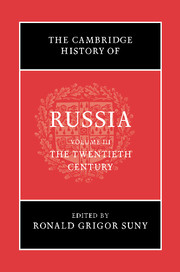Book contents
- Frontmatter
- Introduction
- 1 Reading Russia and the Soviet Union in the twentieth century: how the ‘West’ wrote its history of the USSR
- Part I Russia and the Soviet Union: The Story through Time
- Part II Russia and the Soviet Union: Themes and Trends
- 14 Economic and demographic change: Russia’s age of economic extremes
- 15 Transforming peasants in the twentieth century: dilemmas of Russian, Soviet and post-Soviet development
- 16 Workers and industrialization
- 17 Women and the state
- 18 Non-Russians in the Soviet Union and after
- 19 The western republics: Ukraine, Belarus, Moldova and the Baltics
- 20 Science, technology and modernity
- 21 Culture, 1900–1945
- 22 The politics of culture, 1945–2000
- 23 Comintern and Soviet foreign policy, 1919–1941
- 24 Moscow’s foreign policy, 1945–2000: identities, institutions and interests
- 25 The Soviet Union and the road to communism
- Bibliography
- Index
- References
14 - Economic and demographic change: Russia’s age of economic extremes
from Part II - Russia and the Soviet Union: Themes and Trends
Published online by Cambridge University Press: 28 March 2008
- Frontmatter
- Introduction
- 1 Reading Russia and the Soviet Union in the twentieth century: how the ‘West’ wrote its history of the USSR
- Part I Russia and the Soviet Union: The Story through Time
- Part II Russia and the Soviet Union: Themes and Trends
- 14 Economic and demographic change: Russia’s age of economic extremes
- 15 Transforming peasants in the twentieth century: dilemmas of Russian, Soviet and post-Soviet development
- 16 Workers and industrialization
- 17 Women and the state
- 18 Non-Russians in the Soviet Union and after
- 19 The western republics: Ukraine, Belarus, Moldova and the Baltics
- 20 Science, technology and modernity
- 21 Culture, 1900–1945
- 22 The politics of culture, 1945–2000
- 23 Comintern and Soviet foreign policy, 1919–1941
- 24 Moscow’s foreign policy, 1945–2000: identities, institutions and interests
- 25 The Soviet Union and the road to communism
- Bibliography
- Index
- References
Summary
The enduring fascination with Russia’s twentieth-century economic history has its roots in the politics of revolution. For the Bolshevik leadership, the events of 1917–18 presaged the foundation of a more equitable, humane and modern economic and social order, one that would hold out hope to millions of oppressed and impoverished people within and beyond Russia’s borders. For the Bolsheviks’ opponents, the revolution was destructive and barbaric, reversing a half-century of prior economic progress under the tsarist regime, for the sake of what seemed to many of them to be dubious social and economic goals. These sharply polarised opinions have, to a greater or lesser extent, coloured the way in which later generations have assessed the aspirations and the performance of the Russian economy during the twentieth century. When Stalin launched an extraordinarily ambitious programme of economic modernisation and social change upon the Soviet Union after 1928, jettisoning traditional forms of agricultural organisation and cementing a system of central economic planning, the controversy between enthusiasts and sceptics only deepened. The enthusiasts pointed to rapid economic growth and dramatic technological change during the 1930s, contrasting this with the prolonged depression in the capitalist West. Victory in the war against Nazism seemed to them to have validated the Stalinist industrial revolution. For their part, the sceptics questioned the magnitude of economic growth, drew attention to systemic deficiencies and highlighted the widespread terror and population losses.
Keywords
- Type
- Chapter
- Information
- The Cambridge History of Russia , pp. 381 - 410Publisher: Cambridge University PressPrint publication year: 2006
References
- 2
- Cited by



